Do any of y’all who wear glasses or contact lenses wonder how they work? Or maybe you’ve wondered why your reflection is upside down when you look at a spoon! In this section of the MCAT, you’ll find out the answers to your questions!
Topics covering lights and optics are a bit more unique on the MCAT as you can view them, in a way, as one of the stand alone sections. There aren’t many overlaps you can make with the other MCAT topics, but they’re still important nonetheless!
In this chapter overview, we’ll go over the basic properties of light as well as the fundamental principles of how light plays a role in optical phenomena. Let’s get started!
Lights and Optics on the MCAT: What You Need to Know
Topics on lights and optics will be tested on the Chem/Phys section of the MCAT and can appear both as passage based and fundamental discrete questions.
Similar to fluids and circuits, lights and optics are some of the topics that may have a bit more emphasis on the MCAT – try and expect around 7-9 questions that cover these topics.
Introductory physics accounts for 25% of the content covered in the Chemical and Physical Foundations of Biological Systems.
Important Sub-Topics: Lights and Optics
There are a lot of different optical phenomena that you’ll encounter when studying these topics such as reflection, refraction, polarization, etc. It’s almost to the point where it gets hard to remember what each term means!
A good way to memorize and differentiate between these terms is to make a visual, perhaps a table! Write the term in bold or underline, define it, and draw a visual representation of what occurs and include any relevant equations!
1. Electromagnetic Properties of Light
As indicated by the section title, light is an electromagnetic wave! When talking about light in reference to optics, we’ll mostly consider its nature as a wave. Light also has dual nature as a particle in the form of photons, but that’s better reserved in the context of atomic emission and absorption spectrums.
Being an electromagnetic wave, light can create both electric and magnetic fields. These fields are perpendicular to one another, as shown in the figure below!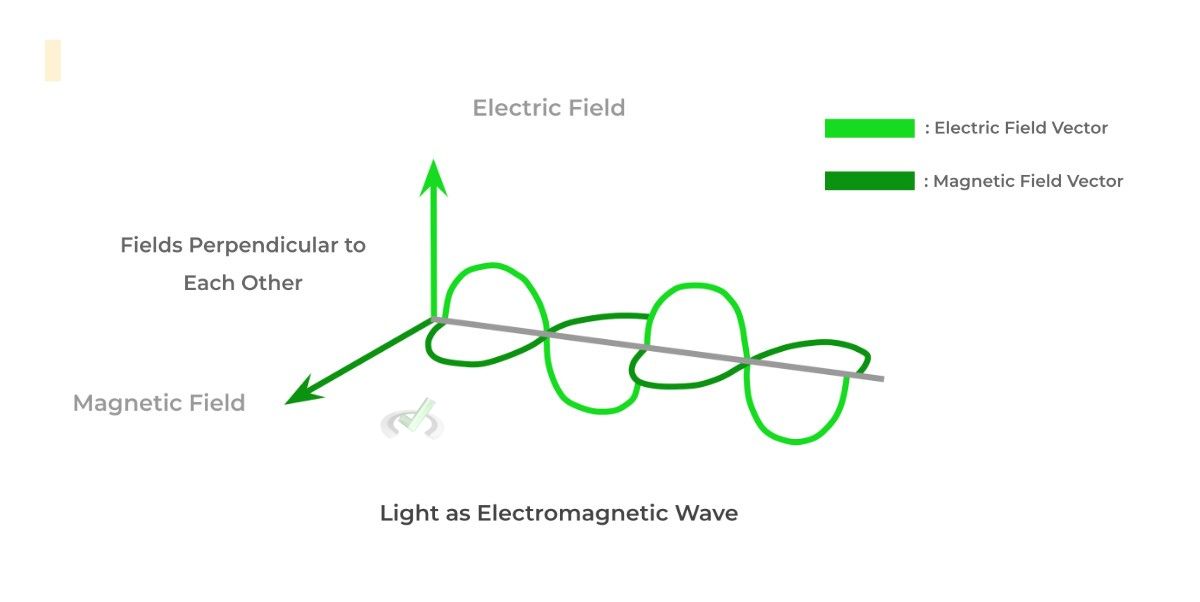
Light exists in a wide variety of wavelengths and frequencies, with this range being the electromagnetic (EM) spectrum. These include waves that we use in daily life, from radio waves to listening to car jams and microwaves to cook our food!
An important range of wavelengths within the EM spectrum is the visible spectrum, which is the light we use to detect color in our surroundings!
This range goes from wavelengths of 400 nm to 700 nm, which represents the colors going from purple to red, respectively – this is the only set of wavelengths in the EM spectrum you’ll need to memorize!
Additionally, an important equation to know for test day is shown below, which relates the speed of light to the light wave’s frequency and wavelength. Note that this represents an inverse relationship between the light wave’s frequency and wavelength: the larger the frequency, the smaller the wavelength (and vice versa).
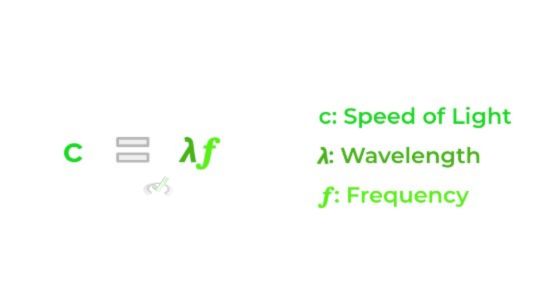
(Coming Soon!) Full Study Notes : Electromagnetic Properties of Light
For more in-depth content review on electromagnetic properties of light, check out these detailed lesson notes created by top MCAT scorers.
2. Reflection and Refraction
These are 2 common principles when talking about how light waves behave when they strike a medium. When light rays strike an object, the rays can reflect back; specifically, when they strike a planar smooth surface at a certain angle, it reflects back at the same angle according to the law of reflection.
In order to find the angle of incidence (and angle of reflection), draw a line that’s perpendicular (called the normal line) to the surface where the light ray strikes. The angle of incidence is the angle formed between the line and the ray, and according to the law of reflection, the angle of reflection will equal the angle of incidence.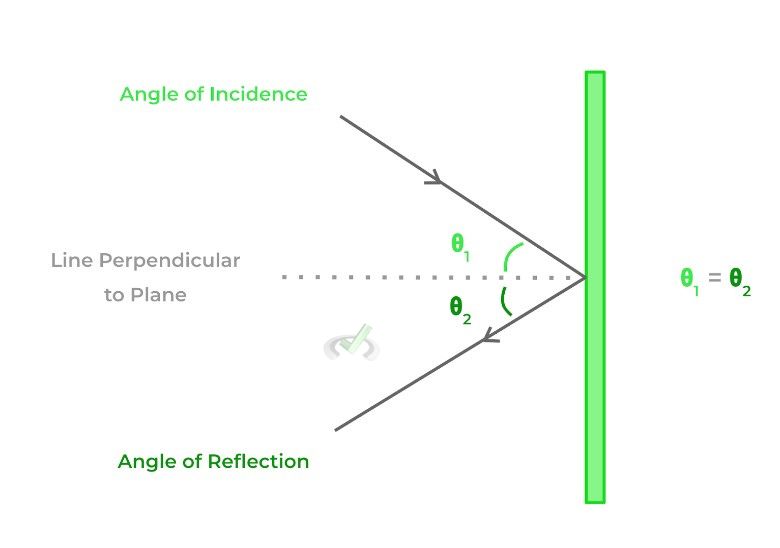
Another important optical phenomenon that occurs is the refraction of light when it enters into a medium. When a light ray strikes a medium such as water or glass, it doesn’t keep on traveling straight; rather, its direction gets bent. Look at the example below!
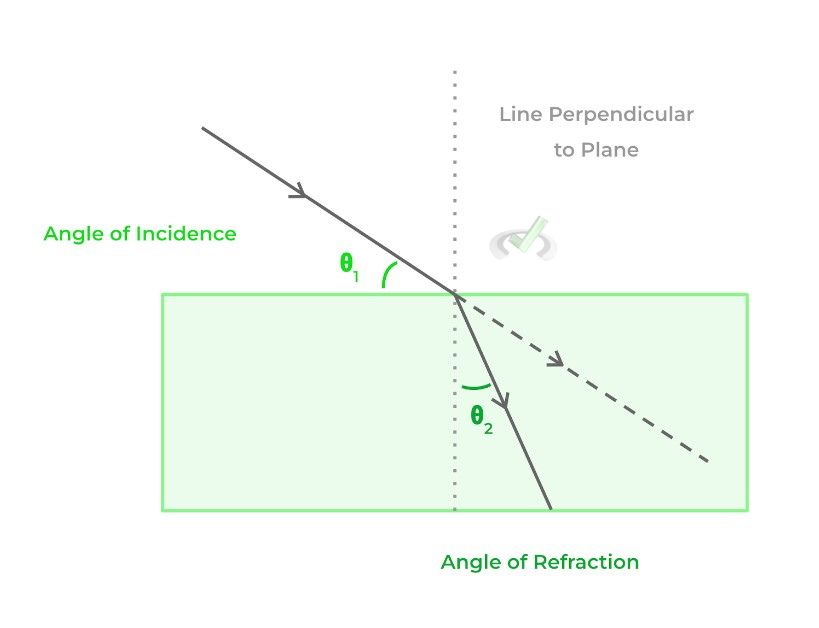
The dotted arrow represents what happens if the ray of light continues to travel in the same direction, which is what doesn’t happen! As shown, the light ray gets refracted and changes direction. Just like in reflection, we use a line perpendicular to the surface, which gives us a reference point for the angles of incidence and refraction.
Each medium has an intrinsic factor called an index of refraction which is a value that can be utilized in an equation called Snell’s law.
This law can help us calculate the angle of refraction when a light ray with an initial angle of incidence strikes a medium with a different index of refraction.

Based on this equation, we can actually already know whether the refracted angle will be smaller or larger than the angle of incidence. In other words, we can also know whether or not the ray bends towards or away from the normal line.
If the ray enters a medium with a GREATER index of refraction (n2 > n1), the ray bends TOWARDS the normal and has an angle of refraction smaller than the angle of incidence.
If the ray enters a medium with a LESSER index of refraction (n1 > n2), the ray bends AWAY from the normal and has an angle of refraction larger than the angle of incidence.
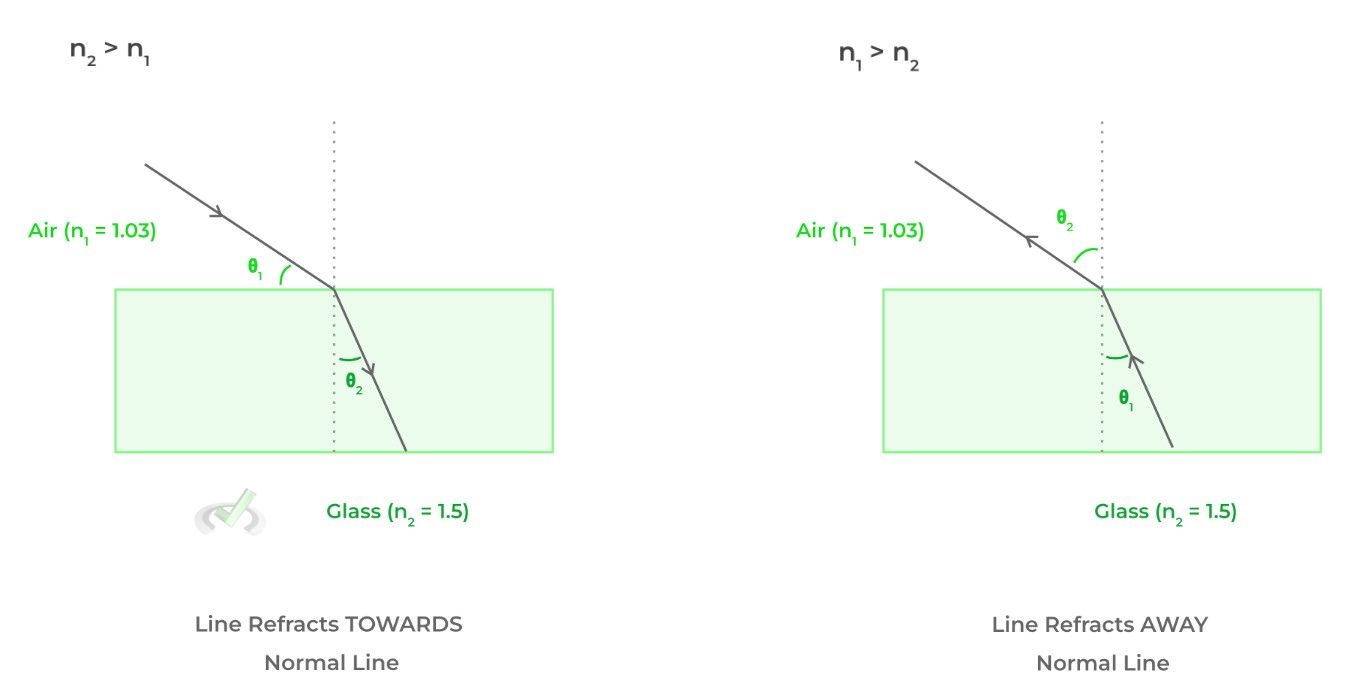
(Coming Soon!) Full Study Notes : Reflection and Refraction
For more in-depth content review on reflection and refraction, check out these detailed lesson notes created by top MCAT scorers.
3. Mirrors and Lenses
We’re all pretty familiar with these tools, whether we’re trying to do our skin care routine in the mirror or using glasses to help us read the lecture board! This is definitely the bulkiest portion of this overall chapter overview and the one that will be most likely tested on!
Let’s start off with mirrors! The main use of mirrors is to project a reflected image using the law of reflection. When light rays originate from the body, they strike the mirror and reflect back, following the law of reflection.
There are 3 main types of mirrors used in everyday life: plane, concave, and convex. As its names suggest, plane mirrors have a flat reflective surface. Concave and convex mirrors are spherical mirrors that are curved inwards and outwards, respectively.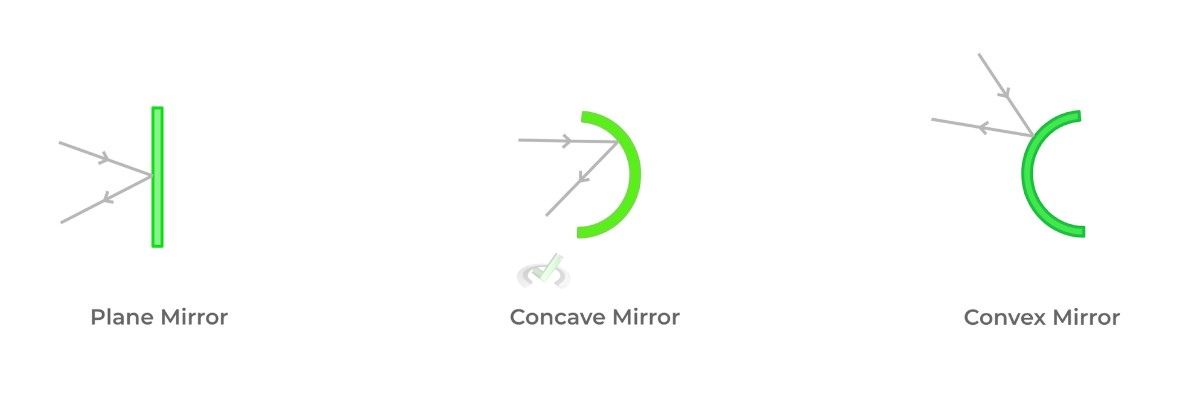
We’ll cover more about these mirrors in our individual article, but the most important fundamental concept to understand – even for lenses – is the difference between real and virtual images. This is one of the topics that can be a little confusing but is much better understood with a visual supplement!
By definition, real images are formed when the reflecting light rays converge to a point in front of the mirror. Conversely, virtual images are formed when the reflecting light rays diverge in front of the mirror.
Another way you might hear this is that real images are always formed in front of the mirror, while virtual images appear to be formed behind the mirror – let’s look at an example to better illustrate this. Look at the 2 mirrors below and notice the difference in their rays.
Notice how in the concave mirror, when the light rays are reflected, they converge at a common point in front of the mirror to produce a real image. On the contrary, the planar mirror reflects the light rays where they all diverge and do not converge at a common point creating a virtual image
Note that plane mirrors only create virtual images, while concave and convex mirrors can generate both real and virtual images. Whether a real or virtual image is generated by a concave/convex mirror depends on the distance of the object from the mirror.
This is where we can use a couple of important terms in order to give us a reference point, which includes the center of curvature (C) and focal point (F).
The center of curvature is basically the imaginary center of the spherical mirror if there was a complete sphere. The focal point is basically the halfway point between the center of curvature and the spherical mirror.
From this, the distance between the center of curvature to the mirror is called the radius of curvature (r), and the focal length (f) is the distance from the focal point to the mirror. Look at the visual below! We’ll cover a lot more about various patterns and relationships you can memorize in our article, but this should give you a good baseline!

As mentioned above, lenses are utilized for refracting light which can help correct vision by either converging or diverging incoming light rays if the lens is convex or concave, respectively.
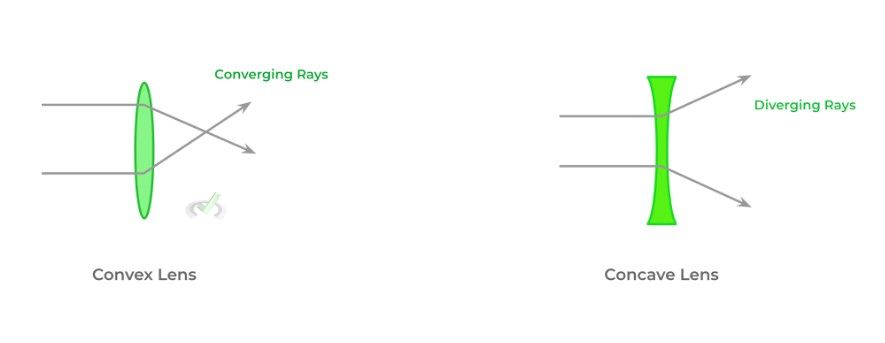
An important concept to understand with lenses is that there are actually 2 refractions that occur. When the light ray first enters the lens, it gets refracted once. Then, the light rays return back to the air, marking the second refraction.
In some cases, the MCAT will tell you to assume that the thickness of the lens is so small that you can assume that only 1 refraction occurs. Other times, this won’t be the case and you will have to account for the thickness. We’ll cover more of this in our specialized article!
Great ways to see the usefulness and impact of lenses are in myopia (nearsightedness) and hyperopia (farsightedness). In these visual conditions, the lenses of the eyes (which is actually a convex lens) aren't refracting the light properly.
In myopia, the convergence of the rays occurs in front of the retina while in hyperopia, the convergence of the rays occurs behind the retina. A concave and convex lens helps correct myopia and hyperopia, respectively, as shown in the visual below!
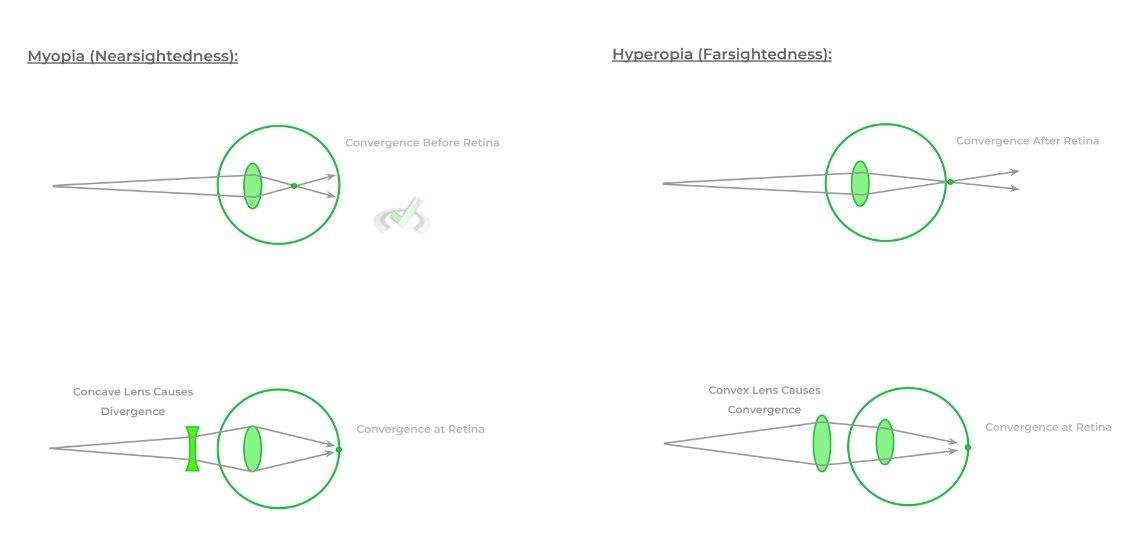
Similar to mirrors, lenses also have centers of curvature, focal points, radius of curvatures, and focal lengths. While the above should give you a good introduction to mirrors and lenses, we’ll cover more of their properties and important topics in this article!
(Coming Soon!) Full Study Notes : Mirror and Lenses
For more in-depth content review on mirror and lenses, check out these detailed lesson notes created by top MCAT scorers.
4. Diffraction and Slit Systems
Now that we’re done with the bulkiest part of light and optics, we can get into the more low yield stuff – these are still important, but may not have as big an emphasis on the MCAT compressed to mirrors and lenses!
Diffraction refers to the bending of light when it has to go around objects or passes through a small opening. Note it’s somewhat similar to refraction except that in refraction, the light is bending as a result of going through a medium rather than around or through a small opening.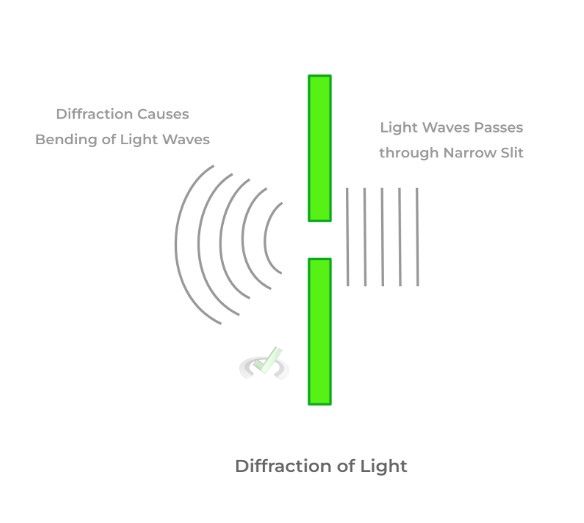
It might be at first counterintuitive at first, but it may help to be put into a more common scenario like sound. In the figure below, when the light waves pass through the slits, the waves become bent and spread out. The same thing happens for sound on a larger scale!
Let’s say our friend is having a conversation in another room with the doorway open and you’re positioned in the other room as shown. Even though sound waves travel in straight lines, the sound waves become diffracted when entering the doorway and bend so that you can also hear the conversation!
Slit systems are a great way to visualize the effect of diffraction where after the slit, there is a screen where a diffraction gradient can be displayed. The most common ones that you’ll be tested on are single and double slits systems!
An interesting phenomenon on slit systems is that bent waves can actually interfere with one another! Interference means that 2 waves interact or come together, and they can generate a new resulting wave with a different amplitude.
When waves constructively interfere, the 2 amplitudes of the waves add together where they generate a wave with greater amplitude. When they deconstructively interfere, the amplitudes add where they generate a smaller amplitude.
This is exactly what happens when there’s a diffraction pattern generated when you do a single or double slit diffraction. The diffraction pattern generated on the screen has bright and dark regions.
The bright regions correspond to where constructive interference occurs, which results in an increased intensity of light. Conversely, the dark regions correspond to deconstructive interference.
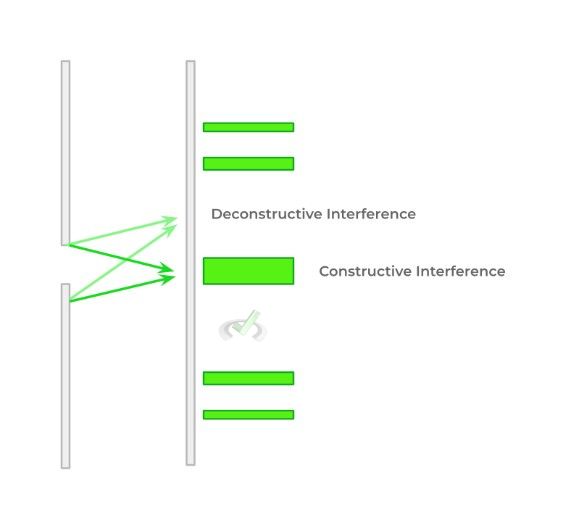
(Coming Soon!) Full Study Notes : Diffraction and Slit Systems
For more in-depth content review on diffraction and slit systems, check out these detailed lesson notes created by top MCAT scorers.
5. Polarization and Dispersion
These are some of the more low yield topics on lights and optics and are best viewed in the context of application. Let’s go ahead and briefly discuss these 2 optical phenomena.
Recall that light has an electric field vector. However, in traveling light waves, the electric field vectors of the waves are not always pointed in the same direction. We can use a polarizing filter to polarize the light so that only light waves with a certain electric field vector direction pass through!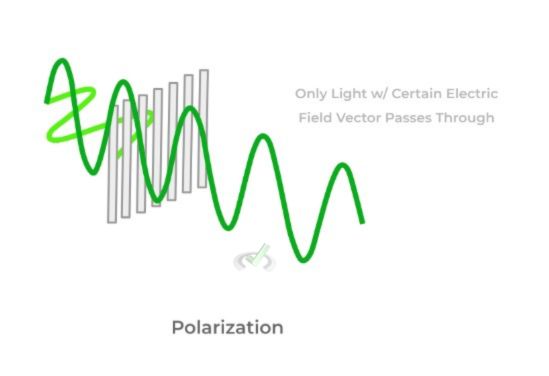
You’ve all for sure have seen the process of dispersion in action when you see a rainbow of colors generated by a prism! Dispersion occurs when light waves of different wavelengths separate from one another when refracted in a prism!
This is because light at different wavelengths will travel at different speeds and, as a result, will be refracted differently to where the different wavelengths separate from one another. The light that best results in dispersion is white light, which has roughly an even mixture of light waves from the entire visible spectrum.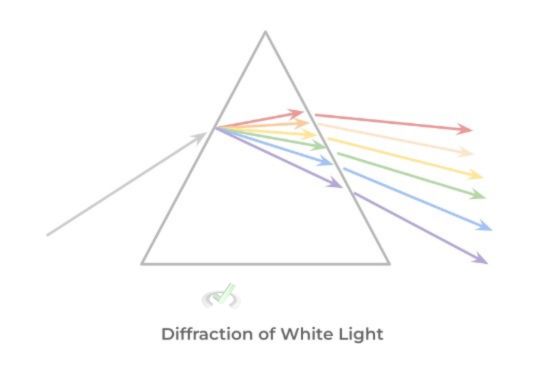
(Coming Soon!) Full Study Notes : Dispersion and Polarization
For more in-depth content review on dispersion and polarization, check out these detailed lesson notes created by top MCAT scorers.
Important Definitions and Key Terms
Below are some high yield definitions and key terms to refer to when reviewing concepts and ideas about light and objects!
Term | Definition |
|---|---|
Electromagnetic Spectrum | The collection of wavelengths and frequencies that electromagnetic light waves can have |
Visible Spectrum | The portion of the electromagnetic spectrum which contains the wavelengths and frequencies for the light that we use to detect colors in our surroundings |
Reflection | Property of light which allows it to bounce back after striking a reflective surface |
Refraction | Property of light which causes it to bend when it enters into a medium |
Index of Refraction | Intrinsic property of materials which causes different objects to refract light differently from one another |
Mirror | Objects with a reflective surface which allows for the reflection of light; The 3 main types of mirrors are plane, concave, convex |
Center of Curvature | The point for a spherical mirror which represents the imaginary center if the sphere was completed |
Radius of Curvature | The distance from the center of curvature to the mirror |
Focal Point | The point between the center of curvature and the mirror |
Focal Length | The distance from the focal point to the mirror |
Lenses | Optical tools which allow for vision correction due to the refraction of light; Divided into concave and convex lenses |
Diffraction | The process where light waves bend when encountering an object or a small opening |
Polarization | The process where light waves with only a certain electric field vector direction are permitted to enter a polarization filter |
Dispersion | The separation of light (usually white light) via their different wavelengths when passing through a prism as a result of their different refractions |
Additional Reading Links (Coming Soon!) – Study Notes for Lights and Optics on the MCAT
Additional Reading: Physics Topics on the MCAT:
- Circuits on the MCAT
- Electrostatics on the MCAT
- Fluids on the MCAT
- Kinematics on the MCAT
- Atomic and Nuclear Phenomena on the MCAT
- Magnetism on the MCAT
- Thermodynamics on the MCAT
- Units and Dimensional Analysis on the MCAT
- Waves and Sound on the MCAT
- Work and Energy on the MCAT

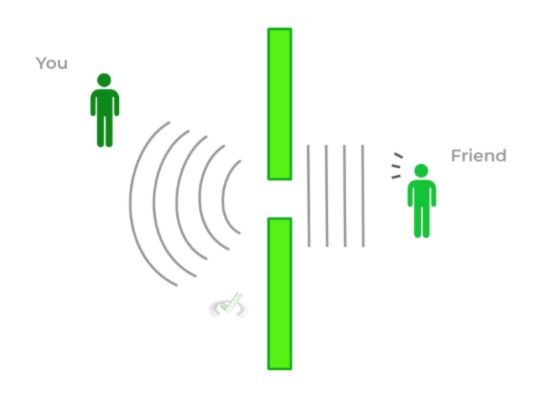

 To help you achieve your goal MCAT score, we take turns hosting these
To help you achieve your goal MCAT score, we take turns hosting these